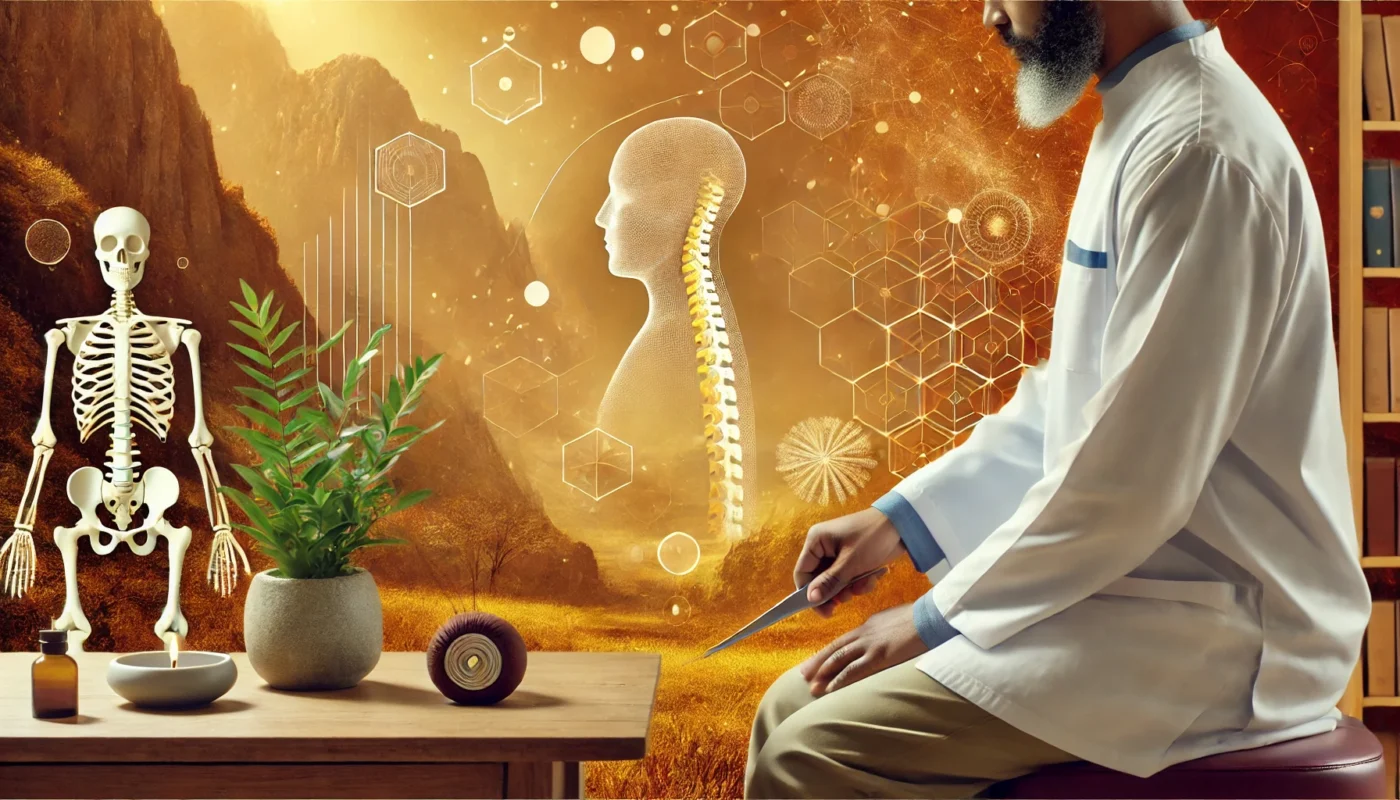In the quest for optimal health and wellness, many individuals are exploring beyond the boundaries of conventional medicine. They are turning to alternative therapies, a realm of healthcare that offers a diverse array of treatment options.
Alternative therapies encompass a broad spectrum of practices. These range from acupuncture to herbal medicine, from yoga to chiropractic care. They are often rooted in ancient traditions and holistic philosophies, focusing on the whole person rather than isolated symptoms.
So, let’s embark on this journey of exploration, delving into the fascinating world of alternative therapies and their potential benefits for health and wellbeing.
You may also like: Finding Local Alternative Medicine Practitioners
Understanding Alternative Therapies and Their Place in Healthcare
Alternative therapies are diverse practices not traditionally part of mainstream medicine. They range from well-known practices like acupuncture to more niche approaches such as Ayurveda. These therapies emphasize holistic care, addressing not just physical symptoms but emotional and spiritual wellbeing as well.
Within the healthcare landscape, these therapies have carved a niche by providing personalized care. This approach can be especially beneficial for individuals seeking a more tailored health strategy. Patients are drawn to their emphasis on natural healing and prevention, offering a contrast to conventional treatment’s focus on disease management.
CAM, an acronym for Complementary and Alternative Medicine, encompasses these diverse practices. “Complementary” therapies work alongside conventional treatments, while “alternative” therapies replace them. This distinction highlights their role in enhancing traditional healthcare rather than replacing it entirely.
A growing number of people are open to integrative medicine, which combines traditional and alternative therapies. This approach seeks the best outcomes by leveraging the strengths of both medical paradigms. Here are some common alternative therapies:
- Acupuncture
- Chiropractic care
- Herbal remedies
- Meditation and yoga
- Homeopathy
These therapies have become more accepted in healthcare settings, partly due to increasing patient demand. As research supports their benefits, they are becoming mainstream, reflecting a significant shift in how we perceive health and wellness.
While alternative therapies emphasize a holistic approach, conventional medicine remains the cornerstone of modern healthcare, providing evidence-based treatments for various conditions. Understanding the strengths and limitations of conventional medicine can help individuals make more informed choices about integrating alternative therapies into their health regimen.
Defining Alternative Therapies
Alternative therapies are distinct from conventional medical practices, often rooted in traditional wisdom. They focus on promoting the body’s natural ability to heal itself. This is achieved through techniques that consider a patient’s physical, emotional, and spiritual health.
These therapies are considered “alternative” because they aren’t always included in standard medical curricula. Examples include acupuncture, which involves inserting needles into specific body points, or herbal medicine, which utilizes plant-based remedies.
Despite their alternative label, many of these therapies are rigorously studied and widely used globally. The push towards evidence-based practice is helping shift their perception from unconventional to integrated care options in health systems worldwide.
The Rise of CAM in Modern Healthcare
CAM’s popularity is surging as more people seek to complement their healthcare with natural options. This rising trend is evident in the increasing adoption of practices like meditation and yoga. Patients are drawn to the holistic benefits that these therapies offer, such as stress relief and enhanced mental clarity.
Healthcare practitioners also recognize the value of CAM, incorporating these techniques into their practice. This integration reflects a broader trend towards personalized medicine, where treatments are tailored to individual needs and preferences. Patients and doctors alike are intrigued by the promise of fewer side effects and more natural treatment paths.
As CAM’s popularity grows, so does the body of research supporting its effectiveness. Studies continue to explore how these therapies can benefit those with chronic conditions, paving the way for wider acceptance. This research helps medical professionals and patients understand their potential role in comprehensive health care.
Holistic Health: Treating the Whole Person
Holistic health is a cornerstone philosophy of alternative therapies, aiming to treat the entire individual. Unlike conventional methods that often focus on symptoms, holistic health embraces the interconnectedness of mind, body, and spirit.
This approach recognizes that physical health is deeply connected to emotional and psychological wellbeing. Practitioners of holistic therapies consider factors such as lifestyle, environment, and mental state. This comprehensive view aims to promote long-lasting health and prevent illness.
By focusing on the whole person, holistic health encourages proactive wellness. Patients are empowered to take an active role in their healing journey. This approach often leads to greater patient satisfaction and improved health outcomes, laying the groundwork for a more balanced and fulfilling lifestyle.

Ten Examples of Complementary Medicine in Healthcare
Complementary medicine offers diverse methods that work alongside conventional treatments. These approaches tap into ancient wisdom and modern innovation. Let’s explore ten examples that illustrate the range of these therapies.
- Acupuncture: Enhances pain management and alleviates stress.
- Chiropractic Care: Aligns the spine, promoting overall wellbeing.
- Herbal Medicine: Employs plant-based remedies for various ailments.
- Meditation: Cultivates mental clarity and reduces stress.
- Yoga: Improves flexibility and fosters a peaceful mind.
- Tai Chi: Encourages gentle movement and balance.
- Homeopathy: Uses highly diluted substances to trigger the body’s healing response.
- Naturopathy: Emphasizes diet, exercise, and lifestyle changes.
- Reiki: Utilizes energy fields to encourage emotional healing.
- Traditional Chinese Medicine (TCM): Balances body energy through herbs, acupuncture, and diet.
These examples highlight how complementary medicine encompasses a wide array of therapies. Each offers unique benefits, from physical relief to mental enhancement.
Acupuncture and Its Role in Pain Management
Acupuncture involves inserting thin needles into strategic body points. This ancient Chinese practice is renowned for its ability to manage pain. Research supports its effectiveness, particularly for headaches and lower back pain.
Beyond pain relief, acupuncture is also used for stress reduction and improving sleep. It helps balance the body’s energy, or “Qi,” which is believed to promote healing. Patients often report a feeling of relaxation during and after sessions.
Scientific studies have explored the efficacy of acupuncture, particularly in managing chronic pain and reducing inflammation. Research continues to uncover its broader therapeutic benefits, making it a compelling option for those seeking non-pharmaceutical pain relief.
Chiropractic Care: Beyond Back Pain
Chiropractic care focuses on diagnosing and treating musculoskeletal disorders. While often associated with back pain, its benefits extend beyond that. Chiropractors make adjustments to the spine, which can relieve tension and restore movement.
These adjustments can also improve posture and alleviate headaches. Some people experience better digestion and enhanced immune function. Chiropractic care’s holistic approach has made it a popular choice for those seeking natural pain relief.
Herbal Medicine: Nature’s Pharmacy
Herbal medicine is one of the oldest forms of healing, using plants for medicinal purposes. Herbs like ginger, echinacea, and turmeric are common in this practice. They address issues ranging from inflammation to immune support.
Herbal medicine leverages the active compounds in plants, such as antioxidants and essential oils. This approach is widely used for its therapeutic benefits and minimal side effects. However, it’s crucial to consult professionals due to potential interactions with conventional drugs.
Mind-Body Practices: Meditation, Yoga, and Tai Chi
Mind-body practices focus on the profound connection between thoughts and physical health. Meditation, yoga, and Tai Chi are key practices in this category. They cultivate mindfulness, reduce stress, and enhance physical flexibility.
Meditation promotes a calm mind and has been linked to reduced anxiety and better emotional health. Yoga enhances strength and balance, while also fostering spiritual growth. Tai Chi combines movement and breath control to improve overall wellbeing.
Homeopathy and Naturopathy: Alternative Healing Systems
Homeopathy operates on the principle of “like cures like,” using diluted substances to treat symptoms. It aims to stimulate the body’s self-healing abilities. Though controversial, many find it effective for allergies and minor ailments.
Naturopathy integrates nutrition, lifestyle, and natural therapies to promote health. It emphasizes prevention and the body’s capacity to heal itself. This approach often includes dietary changes, exercise, and stress management techniques. Together, they form a comprehensive strategy for wellness.
Integrating CAM into Traditional Healthcare Settings
The merging of Complementary and Alternative Medicine (CAM) with conventional healthcare is a growing trend. This integration seeks to enhance patient care by offering more holistic options. It’s a shift towards a more inclusive approach.
Healthcare facilities are beginning to recognize the benefits of CAM. They aim to provide comprehensive care by including alternative therapies in standard treatment protocols. This synergy can lead to improved patient outcomes and satisfaction.
Here are some ways CAM is integrated into healthcare settings:
- Offering acupuncture sessions in pain management clinics.
- Incorporating yoga and meditation classes for stress reduction.
- Providing nutritional counseling alongside conventional treatments.
However, this integration is not without challenges. It requires changes in hospital policies and practices, as well as open-minded collaboration among healthcare providers. The goal is to create a balanced environment where both treatment types coexist harmoniously.
Education plays a critical role in this process. Training healthcare professionals about CAM can reduce skepticism and enhance patient care. It’s crucial for practitioners to understand both the benefits and limitations of alternative therapies.
Globally, healthcare systems incorporate a variety of medical practices tailored to different cultural and regional needs. Examining how medicine is practiced worldwide can provide a broader perspective on the integration of conventional and alternative therapies.

CAM Therapies in Hospitals and Clinics
Hospitals and clinics are increasingly incorporating CAM therapies into their services. This trend acknowledges the growing demand for holistic care among patients. Offering alternative options can set healthcare facilities apart.
Acupuncture is one example of CAM being used in traditional medical settings. It’s employed to alleviate pain and manage conditions like nausea in cancer patients. Its presence in clinical environments underscores its legitimacy as a complementary therapy.
Likewise, yoga is offered in many hospitals to aid mental health and promote relaxation. It supports traditional treatments for stress, anxiety, and depression. By doing so, healthcare facilities can cater to the whole patient, not just physical ailments.
The Role of CAM in Chronic Disease Management
CAM is pivotal in managing chronic diseases, where long-term care and lifestyle changes are essential. These therapies can complement conventional treatments, offering patients a broader range of options.
For instance, herbal medicine is used alongside pharmaceutical treatments to manage symptoms of conditions like arthritis. Patients often find that combining these approaches offers relief when conventional methods fall short.
Mind-body practices, such as meditation and tai chi, are also valuable in chronic disease management. They help reduce stress, improve mental clarity, and enhance the quality of life for individuals with chronic conditions. This holistic perspective can lead to more sustainable health outcomes.
Collaboration between traditional and alternative practitioners is critical. Through unified care plans, patients receive coordinated and comprehensive treatment. This collaborative effort can significantly improve the management of chronic diseases.
Why Some Doctors May Be Skeptical of Alternative Medicine
Despite the growing popularity of alternative medicine, skepticism remains prevalent among many doctors. This skepticism often stems from various concerns that practitioners have regarding safety and efficacy. It’s important to explore these reservations to bridge gaps in understanding.
First, the rigorous training that conventional doctors undergo focuses heavily on evidence-based medicine. This scientific approach underpins their skepticism towards therapies lacking substantial research. They prioritize treatments with clear, measurable outcomes.
Additionally, doctors are accountable for patient safety and outcomes. Without conclusive evidence, they may hesitate to endorse treatments that could endanger patients. Patient harm is a significant concern that drives many practitioners to caution.
Skepticism also arises from potential interactions between alternative remedies and conventional treatments. Herbal supplements, for example, can interact with pharmaceuticals in unpredictable ways. Such interactions pose safety risks that concern healthcare providers.
Here are some common reasons for skepticism:
- Lack of robust evidence to support alternative treatments.
- Potential safety risks from unregulated products.
- Concerns over interactions with prescribed medications.
Doctors may also fear that alternative therapies divert patients from necessary, evidence-based medical care. This concern is particularly acute in cases of serious illnesses where time is critical. Delayed conventional treatment can lead to worsening conditions.
Understanding these reasons can foster better communication between practitioners of both fields. It’s crucial for doctors and CAM practitioners to work collaboratively for the patient’s benefit.
Lack of Evidence and Research Challenges
A major reason for skepticism is the perceived lack of evidence supporting alternative therapies. Many CAM practices are not subjected to the rigorous clinical trials that conventional treatments undergo. This gap in research makes it difficult for doctors to validate these therapies.
Funding for large-scale studies on alternative medicine is limited. Pharmaceutical companies often invest in drugs with higher profitability, leaving CAM studies underfunded. This financial disparity results in fewer high-quality trials for alternative therapies.
Moreover, the methodologies used in CAM research can differ from conventional practices. These differences sometimes lead to challenges in interpreting results. Doctors trained in evidence-based medicine may find these studies lacking standardization.
Inconsistent study results further compound this issue. With varied outcomes, it’s hard to draw definitive conclusions about the efficacy of alternative treatments. Reliable evidence is crucial for doctors to confidently recommend therapies to patients.
Training and Education Gaps in CAM
Another source of skepticism is the lack of training and education in CAM for traditional healthcare providers. Most medical schools focus on evidence-based practices and do not cover alternative therapies extensively. This omission leaves doctors unfamiliar with the potential benefits of CAM.
Doctors trained solely in conventional medicine may find it challenging to assess the safety and efficacy of alternative treatments. Without the necessary education, they may feel uncomfortable recommending these therapies to patients.
Furthermore, there is a gap in professional accreditation and licensing for many CAM practitioners. This lack of standardized qualifications can cause concern about the expertise and reliability of alternative therapists. Doctors prioritize patient safety and quality care, making this an important issue.
Addressing these training gaps could facilitate better integration of CAM into traditional healthcare. Collaborative learning initiatives and continuing education programs could equip doctors with a more comprehensive understanding of alternative therapies.

Categories and Types of Alternative Therapies
Alternative therapies encompass a diverse range of practices aimed at promoting health and wellness. These therapies often focus on natural and holistic approaches that consider the individual’s whole being. They are typically categorized into several distinct types, each offering unique benefits.
One common category is mind-body practices. These therapies emphasize the connection between mental and physical health. Techniques such as meditation and yoga are popular examples that foster relaxation and stress reduction.
Another category is biologically based therapies. These involve the use of substances found in nature, like herbs and supplements. These are often used to support health through natural means.
Energy therapies focus on the body’s energy fields. Practices such as Reiki and Qigong aim to balance and enhance the flow of energy throughout the body. This is believed to promote healing and wellbeing.
Movement therapies like Pilates and the Feldenkrais Method enhance physical function and improve movement efficiency. They emphasize body awareness and alignment, offering physical and mental benefits.
Traditional healers and indigenous practices involve healing methods rooted in cultural traditions. These practices are passed down through generations and often involve a combination of herbal medicine, rituals, and spiritual healing.
Here’s a summary of the categories:
- Mind-body practices: Focus on mental-physical health connections.
- Biologically based therapies: Use herbs and supplements.
- Energy therapies: Manipulate body energy fields.
- Movement therapies: Enhance physical function and awareness.
- Traditional healing: Cultural and spiritual healing methods.
By understanding these categories, individuals can choose therapies that align with their health goals.
Healthcare today offers a diverse range of medical approaches, from conventional Western medicine to alternative and integrative treatments. Exploring the different types of medicine available can provide valuable insights into how various practices contribute to overall health and wellness.
Mind-Body Practices and Their Impact on Wellness
Mind-body practices aim to unify mental and physical health, enhancing overall wellbeing. Techniques like meditation promote relaxation and mental clarity, helping reduce stress levels. These practices create a sense of calm and balance.
Similarly, practices such as yoga and Tai Chi integrate movement and mindfulness. They improve flexibility and strength while calming the mind. Collectively, mind-body practices empower individuals to maintain a healthy life balance.
Biologically Based Therapies: Supplements and Herbs
Biologically based therapies utilize natural products, including herbs and dietary supplements. These are used to support and enhance health. Herbal medicine draws on nature’s pharmacy, offering remedies for a wide range of ailments.
Supplements provide nutrients that might be missing from one’s diet. They are often used to boost immunity and energy. Natural products in these therapies offer an alternative approach to health management, often with fewer side effects.

Energy Therapies: Reiki and Qigong
Energy therapies are based on the concept that energy flows through and surrounds us. Reiki and Qigong are practices that tap into this energy to promote healing. Reiki involves hands-on energy transfer to facilitate balance and remove blockages.
Qigong uses specific movements and breathing techniques to cultivate and balance life energy. These therapies aim to enhance wellbeing by aligning the body’s energy systems. They are accessible and gentle forms of therapy that appeal to many seeking holistic healing.
Movement Therapies: Pilates and Feldenkrais
Movement therapies focus on enhancing physical motion and overall body function. Pilates strengthens the core while improving posture and flexibility. It promotes mindful movement, emphasizing control and precision.
The Feldenkrais Method increases movement awareness and efficiency. By focusing on how one moves, it helps release habitual patterns and pain. Both of these methods enhance physical and mental harmony through thoughtful exercise.
Traditional Healers and Indigenous Practices
Traditional healers draw upon a deep well of cultural knowledge and spirituality. Practices vary, involving herbal remedies, rituals, and spiritual healing. These methods honor ancestral traditions and community-centric healing practices.
Indigenous approaches often blend spirituality and natural medicine, fostering a deep connection with nature. Traditional healers play an integral role in many cultures, offering personalized and holistic care. They focus on restoring balance in mind, body, and spirit.
The Science Behind Alternative Therapies
Alternative therapies, with their diverse range of practices, have sparked interest and debate within the scientific community. Understanding the science behind these therapies is key for informed use and acceptance. In recent years, rigorous scientific evaluation has increased, aiming to demystify their mechanisms and benefits.
Research on alternative therapies often focuses on their efficacy and safety. While some practices show promising results, others require more robust evidence. The quality of studies can vary, influencing how findings are interpreted.
Several alternative therapies have demonstrated positive outcomes in managing chronic conditions and improving quality of life. These findings encourage ongoing research to confirm their effectiveness. Evidence-based approaches can integrate these therapies into conventional healthcare, enhancing holistic patient care.
Interestingly, the mind-body connection, a staple in alternative medicine, is gaining scientific validation. Studies show that practices like meditation can impact mental and physical health positively. The balance between mental and physical states is a cornerstone of holistic wellbeing.
Research on Holistic Medicine: What Does the Evidence Say?
Holistic medicine emphasizes treating the whole person rather than symptoms alone. Research in this field is expanding, revealing a complex interplay between body, mind, and spirit. Many studies support the efficacy of practices like acupuncture and herbal medicine.
For instance, acupuncture’s role in pain management is backed by several clinical trials. It shows effectiveness in treating migraines, arthritis, and more. These results provide a foundation for integrative approaches in healthcare.
Herbal medicine also garners support through scientific exploration. Herbs like ginger and turmeric demonstrate anti-inflammatory properties. Such findings validate traditional use and encourage further studies to unravel their potential.
Despite these successes, challenges remain. Some therapies lack substantial evidence, highlighting the need for robust research methodologies. Continued exploration will uncover more about the mechanisms and benefits of holistic practices.
Evaluating the Credibility of Alternative Health Information
Navigating alternative health information requires careful evaluation. With so much available online, discerning credible sources is crucial. Consider the credentials and background of authors and publishers when reviewing information. Look for references to peer-reviewed studies that support claims.
Reputable health organizations and academic institutions often publish reliable content. Be wary of anecdotal evidence or claims that seem too good to be true. Scientific validation should underpin the claims of efficacy in alternative therapies.
Transparency in methodology and results is another indicator of credible information. Check if studies mentioned follow rigorous scientific protocols. This ensures the information is grounded in evidence rather than conjecture.
Informed choices in alternative health begin with understanding the research landscape. Educating oneself on evaluating sources helps in accessing accurate information. This knowledge empowers individuals to explore alternative therapies safely and effectively.
Practical Tips for Exploring Alternative Therapies
Embarking on a journey with alternative therapies requires a mindful approach. Start by understanding your health needs and goals. Reflecting on what you hope to achieve can guide your choice of therapies.
Before diving in, research is key. Learn about different types of alternative therapies and their potential benefits. Knowledge empowers you to make informed decisions about your health.
It’s essential to consult your healthcare provider, especially if you have existing health conditions. They can offer advice on integrating alternative therapies safely into your current treatment plan. Open communication ensures comprehensive care.
Exploring alternative therapies often involves finding practitioners. This can be challenging but rewarding. Look for certifications and qualifications relevant to the specific therapy. Practitioners with formal training are more likely to provide safe and effective care.
Attending workshops or informational sessions can be beneficial. They offer firsthand experience and insights into various therapies. Engaging with communities or support groups can also provide valuable perspectives.
Be aware of any red flags when considering a practitioner. Claims of miraculous results or lack of transparency should prompt caution. Trust your instincts if something feels off.
Maintain a record of your experiences with alternative therapies. Note any changes or improvements, however subtle. This documentation can be useful for your healthcare provider to assess the therapy’s impact.
Ultimately, patience is vital. Alternative therapies often emphasize gradual progress and holistic healing. Give yourself time to experience their potential benefits.
How to Find Reliable Alternative Medicine Practitioners Near You
Finding a trustworthy practitioner can enhance your experience with alternative therapies. Start by seeking recommendations from trusted sources. Friends, family, or even your primary care doctor may have valuable suggestions. Personal experiences can lend credibility to the practitioner.
Check professional associations related to the therapy you’re interested in. Many have directories of certified practitioners. These organizations often uphold standards to ensure practitioner competence and safety.
When evaluating potential practitioners, consider their qualifications and experience. Certification can indicate formal training, while years of practice suggest hands-on expertise. A practitioner with a solid reputation often garners positive reviews and testimonials. Online platforms or community forums can provide additional insights.
Don’t hesitate to reach out to practitioners for an initial conversation. Discuss your needs and their approach to treatment. This interaction can offer clues about their professionalism and communication style.
The Future of Alternative Therapies in Healthcare
The landscape of healthcare is evolving with growing interest in alternative therapies. With more research and acceptance, these therapies are increasingly integrated into mainstream medicine. As the boundaries between conventional and alternative medicine blur, patients enjoy more personalized care.
Emerging trends indicate a rise in holistic and patient-centered approaches. Health enthusiasts seek treatments that align with their values and lifestyle. This shift emphasizes prevention and wellness, prompting healthcare systems to adapt.
Policy changes and insurance coverage are expanding access to alternative therapies. These developments could reduce healthcare costs and promote greater use among diverse populations. Accessibility remains a vital factor in the growth of alternative medicine.
Collaboration between traditional and alternative practitioners is also on the rise. Interdisciplinary teams work together to provide comprehensive care. This integrative approach ensures patients benefit from the best of both worlds.
Integrative medicine is gaining traction as more healthcare providers recognize the value of combining conventional treatments with evidence-based alternative therapies. Understanding the principles of integrative medicine can help patients and practitioners work together toward more holistic, personalized healthcare solutions.
Emerging Trends in CAM Research and Practice
Emerging trends in CAM (Complementary and Alternative Medicine) research are encouraging. There is a growing emphasis on evidence-based practices. Researchers are using rigorous scientific methods to validate alternative therapies.
Holistic approaches are gaining traction. They address physical, mental, and emotional wellbeing. This comprehensive perspective resonates with patients seeking more than symptom relief.
Personalized care is another significant trend. Tailoring treatments to individual needs enhances effectiveness. Practitioners consider factors like genetics, lifestyle, and preferences.
These trends reflect a broader shift in healthcare priorities. Patient empowerment and informed decision-making are paramount. As these values become central to care, alternative therapies continue to gain acceptance.
The Role of Technology and Innovation in CAM
Technology is revolutionizing CAM practices. Digital tools enhance accessibility and convenience for practitioners and patients. Online platforms and mobile apps facilitate education and connection.
Innovations such as virtual consultations expand reach. Patients can access expert guidance without geographical limitations. This flexibility fosters greater adoption of alternative therapies.
Wearable devices and data analytics offer insights into health trends. They enable personalized feedback and real-time monitoring. Such technologies improve patient engagement and outcomes.
Research is also benefiting from technological advancements. Data-driven studies provide robust evidence for CAM practices. As technology continues to advance, it supports the growth and credibility of alternative medicine.

Conclusion: Embracing a Balanced Approach to Health and Wellness
Embracing a balanced approach to health and wellness involves integrating the best of both conventional and alternative therapies. This harmony allows for a more comprehensive understanding of personal health needs. By recognizing the strengths of each practice, individuals can make informed decisions.
Alternative therapies offer benefits such as personalization and fewer side effects. They encourage a focus on prevention and whole-person care. Meanwhile, conventional medicine provides well-researched interventions for acute and chronic conditions.
For optimal health, consider your values, lifestyle, and medical history. Engage in open dialogues with healthcare providers about incorporating alternative therapies. This collaboration enhances treatment outcomes and empowers you as a patient.
Fostering a culture of wellness involves acknowledging diverse paths to healing. Whether opting for yoga, acupuncture, or herbal remedies, ensure these practices align with your goals. A balanced approach nurtures not only the body but also the mind and spirit.
Further Reading:
Types of Complementary and Alternative Medicine
Introducing Complementary and Alternative Therapies
Complementary & Alternative Therapies for Autism
Movement Therapies, Pilates, Feldenkrais, Traditional Healers, Indigenous Practices, Alternative Therapies, Holistic Medicine, Mind-Body Connection, Acupuncture, Herbal Medicine, Credibility of Health Information, Patient-Centered Care, Complementary and Alternative Medicine, Technology in CAM, Wellness, Personalized Care
Important Note: The information contained in this article is for general informational purposes only, and should not be construed as health or medical advice, nor is it intended to diagnose, prevent, treat, or cure any disease or health condition. Before embarking on any diet, fitness regimen, or program of nutritional supplementation, it is advisable to consult your healthcare professional in order to determine its safety and probable efficacy in terms of your individual state of health.
Regarding Nutritional Supplements Or Other Non-Prescription Health Products: If any nutritional supplements or other non-prescription health products are mentioned in the foregoing article, any claims or statements made about them have not been evaluated by the U.S. Food and Drug Administration, and such nutritional supplements or other health products are not intended to diagnose, treat, cure, or prevent any disease

